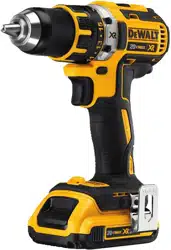Loading ...
Loading ...
Loading ...

FUEL GAUGE BATTERY PACKS (FIG. 7)
Some DEWALT battery packs include a
fuel gauge which consists of three green
LED lights that indicate the levelof charge
remaining in the battery pack.
Toactuate the fuel gauge, press and hold
the fuel gauge button (L). A combination
of the three green LED lights will illuminate
designating the level of charge left. When
the level of charge in the battery is below
the usable limit, the fuel gauge will not
illuminate and the battery will need to be
recharged.
NOTE: The fuel gauge is only an indication of the charge left on the
battery pack. It does not indicate tool functionality and is subject to
variation based on product components, temperature and end-user
application.
For more information regarding fuel gauge battery packs, please call
1-800-4-DEWALT (1-800-433-9258) or visit our website www.dewalt.
com.
FIG.7
L
Drilling (Fig. 8)
NOTICE: If drilling thin material, use a wood "back-up" block to
prevent damage to the material.
1. Select the desired speed/torque range using the gear shifter to
match the speed and torque to the planned operation. Turn the
collar (C)to the drillsymbol.
2. Use sharp drill bits only. For MASONRY, such as brick, cement,
cinder block, etc., use carbide-tipped bits rated for percussion
drilling.
3. Always apply pressure in a straight line with the bit. Use enough
pressure to keep drill biting, but do not push hard enough to stall
the motor or deflect the bit.
4. Hold tool firmly with both hands to control the twisting action of
the drill. If model is not equipped with side handle, grip drill with
one hand on the handle and one hand on the battery pack.
,_,WARNING: Drill may stall if overloaded causing a sudden twist.
Always expect the stall. Grip the drillfirmly to control the twisting action
and avoid injury.
5. IF DRILL STALLS, it is usually because it is being overloaded
or improperly used. RELEASE TRIGGER IMMEDIATELY,
remove drill bit from work, and determine cause of stalling. DO
NOT DEPRESS TRIGGER ON AND OFF IN AN A'rI'EMPT
TO START A STALLED DRILL -- THIS CAN DAMAGE THE
DRILL.
6. To minimize stalling or breaking through the material, reduce
pressure on drill and ease the bit through the last fractional part of
the hole.
7. Keep the motor running when pulling the bit back out of a drilled
hole. This will help prevent jamming.
Screwdriving (Fig. 9)
1. Select the desired speed/torque range using the gear shifter to
match the speed and torque to the planned operation.
2. Turn the torque adjustment collar (C)to the desired position.
NOTE: Use the lowest torque setting required to seat the fastener
at the desired depth. The lower the number, the lower the torque
output.
3. Insert the desired fastener accessory into the chuck as you would
any drill bit.
4. Make some practice runs in scrap or on unseen areas of the
workpiece to determine the proper position of the torque
adjustment collar.
5. Always start with lower torque settings, then advance to higher
torque settings to avoid damage to the workpiece or fastener.
12
Loading ...
Loading ...
Loading ...
